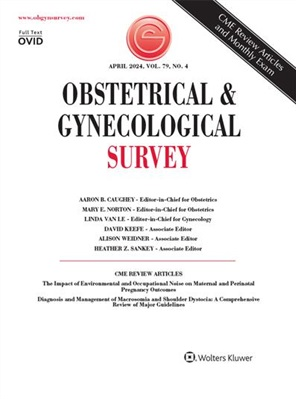Disease-Free Survival Does Not Differ According to Fertility Preservation Technique for Young Women With Breast Cancer
IF 4.3
4区 医学
Q1 OBSTETRICS & GYNECOLOGY
引用次数: 0
Abstract
ABSTRACT Approximately 5% of breast cancer cases occur in women younger than 40 years, and the 5-year overall survival for women between the ages of 15 and 44 years is 90%. As the childbearing age increases, so too does the proportion of women who wish to achieve pregnancy after breast cancer. The conception rate among these women is 40% lower than the general population, as a result of advanced age and the gonadal toxicity of chemotherapy. Fertility preservation (FP) techniques enable young patients to freeze gametes before treatment; however, the most recommended method of FP is oocyte or embryo vitrification after controlled ovarian hyperstimulation (COH), which has limited safety data in breast cancer patients. This retrospective cohort study aimed to evaluate disease-free survival (DFS) in a large cohort of women with breast cancer who underwent FP techniques with or without COH. Patients with breast cancer between 18 and 43 years old referred for FP to 2 university hospitals between July 2013 and July 2019 were included. Women not included in the FP program after oncofertility counseling, those with stage 4 disease at diagnosis or history of other invasive cancer, or those with gonadotoxic treatment have been excluded. Patients were split into 2 groups, with the STIM group receiving at least 1 COH protocol using a gonadotropin-releasing hormone antagonist with or without an aromatase inhibitor and the no STIM group not undergoing ovarian stimulation. Patient characteristics, obstetric variables, and oncology characteristics were collected from medical records. Disease-free survival and overall survival were estimated using Kaplan-Meier plots and compared between the 2 groups by log-rank test. A total of 740 women (76.7%) who attended oncofertility consultations for breast cancer were included. Of these, 328 (44.3%) underwent at least 1 ovarian stimulation cycle, and 412 (55.7%) had an FP technique without exogenous FSH administration. The STIM group was significantly older and had lower values in ovarian reserve tests, and more women in the no STIM group underwent a mastectomy and neoadjuvant chemotherapy. The proportion of patients with hormone receptor-positive tumors was equal in both groups. Letrozole was coadministered with exogenous gonadotropin in 39.3% of women in the STIM group (Let-COH). Overall, 16.8% of patients had a tumor still present on oocyte retrieval after COH, of which 55% received a Let-COH protocol. Follow-up data were available for 80.9% (559/740) of patients. Cancer recurrence was documented in 87 patients (27 in STIM, 60 in no STIM), and DFS was not statistically different between the groups (log-rank test P = 0.09). Neither difference in DFS nor overall survival was observed in the Let-COH group compared with those undergoing COH after breast surgery. Kaplan-Meier estimates of overall survival at 4 years were 97.6% in the STIM and 93.6% in the no STIM groups, and after adjusting for prognostic parameters, the risk of death remained significantly lower in the STIM group (hazards ratio, 0.55 [0.35–0.85]). The results of this large retrospective cohort study demonstrate that the use of COH for FP patients with breast cancer before or after breast tumor surgery is safe; however, a longer duration of follow-up will provide a more definite safety profile.年轻女性乳腺癌患者的无病生存率根据生育能力保存技术并无差异
大约5%的乳腺癌病例发生在40岁以下的女性中,15至44岁女性的5年总生存率为90%。随着生育年龄的增加,乳腺癌后希望怀孕的妇女比例也在增加。由于高龄和化疗的性腺毒性,这些妇女的受孕率比一般人群低40%。生育保存(FP)技术使年轻患者能够在治疗前冷冻配子;然而,最推荐的促生育方法是控制性卵巢过度刺激(COH)后的卵母细胞或胚胎玻璃化,该方法在乳腺癌患者中的安全性数据有限。这项回顾性队列研究旨在评估在有或没有COH的情况下接受FP技术的乳腺癌妇女的无病生存(DFS)。在2013年7月至2019年7月期间,18至43岁的乳腺癌患者因计划生育被转介到两所大学医院。未在生育咨询后纳入计划生育计划的妇女,诊断时患有4期疾病或有其他侵袭性癌症病史的妇女,或接受促性腺毒素治疗的妇女均被排除在外。患者被分为两组,STIM组接受至少1个COH方案,使用促性腺激素释放激素拮抗剂(含或不含芳香酶抑制剂),无STIM组不接受卵巢刺激。从医疗记录中收集患者特征、产科变量和肿瘤学特征。采用Kaplan-Meier图估计无病生存期和总生存期,采用log-rank检验比较两组间的差异。共有740名妇女(76.7%)参加了乳腺癌的肿瘤生育咨询。其中328例(44.3%)接受了至少1次卵巢刺激周期,412例(55.7%)采用了不使用外源性FSH的FP技术。STIM组明显年龄更大,卵巢储备试验值更低,无STIM组更多的妇女接受了乳房切除术和新辅助化疗。两组患者中激素受体阳性肿瘤的比例相等。在STIM组(Let-COH)中,39.3%的女性同时使用来曲唑和外源性促性腺激素。总体而言,16.8%的患者在COH后卵母细胞回收时仍存在肿瘤,其中55%的患者接受了Let-COH方案。80.9%(559/740)的患者可获得随访数据。87例患者出现肿瘤复发(STIM组27例,无STIM组60例),两组间DFS差异无统计学意义(log-rank检验P = 0.09)。与乳房手术后接受COH的患者相比,Let-COH组的DFS和总生存率均无差异。Kaplan-Meier估计,STIM组4年总生存率为97.6%,无STIM组为93.6%,在调整预后参数后,STIM组的死亡风险仍显着降低(风险比为0.55[0.35-0.85])。这项大型回顾性队列研究的结果表明,在乳腺癌肿瘤手术前后使用COH治疗FP乳腺癌患者是安全的;然而,更长的随访时间将提供更明确的安全性概况。
本文章由计算机程序翻译,如有差异,请以英文原文为准。
求助全文
约1分钟内获得全文
求助全文
来源期刊
CiteScore
2.70
自引率
3.20%
发文量
245
审稿时长
>12 weeks
期刊介绍:
Each monthly issue of Obstetrical & Gynecological Survey presents summaries of the most timely and clinically relevant research being published worldwide. These concise, easy-to-read summaries provide expert insight into how to apply the latest research to patient care. The accompanying editorial commentary puts the studies into perspective and supplies authoritative guidance. The result is a valuable, time-saving resource for busy clinicians.

 求助内容:
求助内容: 应助结果提醒方式:
应助结果提醒方式:


